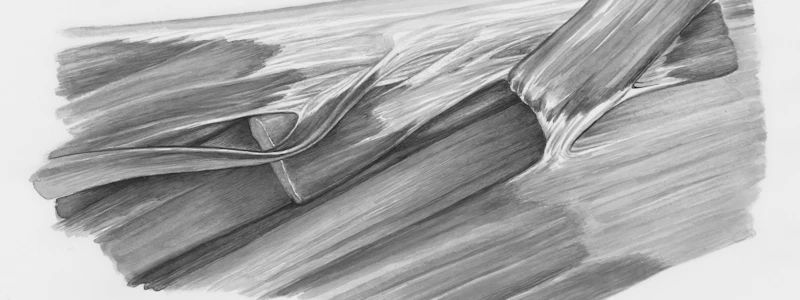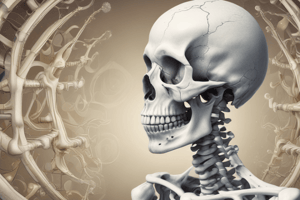Podcast
Questions and Answers
Which type of connective tissue is primarily responsible for holding bones together at the joints?
Which type of connective tissue is primarily responsible for holding bones together at the joints?
- Bone
- Cartilage
- Ligament (correct)
- Muscle
Bone tissue is made up of living cells and does not require any minerals for its structure.
Bone tissue is made up of living cells and does not require any minerals for its structure.
False (B)
What is osteoporosis commonly referred to as?
What is osteoporosis commonly referred to as?
Brittle bones
The _____ connects the femur and tibia and is crucial for preventing joint instability.
The _____ connects the femur and tibia and is crucial for preventing joint instability.
Match the following terms with their definitions:
Match the following terms with their definitions:
What can be a consequence of low Vitamin D levels in relation to bones?
What can be a consequence of low Vitamin D levels in relation to bones?
Sprained ankles only involve damage to tendons.
Sprained ankles only involve damage to tendons.
Name one type of connective tissue found in the musculoskeletal system.
Name one type of connective tissue found in the musculoskeletal system.
Muscles can be classified into three types: skeletal, cardiac, and _____ muscle.
Muscles can be classified into three types: skeletal, cardiac, and _____ muscle.
Which of the following statements is true regarding muscle sprains?
Which of the following statements is true regarding muscle sprains?
Tendons are more elastic than ligaments.
Tendons are more elastic than ligaments.
What principle is followed in the recovery of soft tissue injuries?
What principle is followed in the recovery of soft tissue injuries?
Muscles work in pairs: one acts as a flexor and the other as an __________.
Muscles work in pairs: one acts as a flexor and the other as an __________.
What is a common treatment for tendonitis?
What is a common treatment for tendonitis?
What type of tissue is cartilage primarily composed of?
What type of tissue is cartilage primarily composed of?
Skeletal muscle is an involuntary muscle.
Skeletal muscle is an involuntary muscle.
Name one condition that can arise from the deterioration of cartilage.
Name one condition that can arise from the deterioration of cartilage.
The proteins actin and myosin are essential for muscle ______.
The proteins actin and myosin are essential for muscle ______.
Match the types of muscles with their characteristics:
Match the types of muscles with their characteristics:
What can occur due to a lack of oxygen and sugar in muscles during exercise?
What can occur due to a lack of oxygen and sugar in muscles during exercise?
Micro tears in muscle tissue are harmful and should be avoided.
Micro tears in muscle tissue are harmful and should be avoided.
What is the main role of cartilage in joints?
What is the main role of cartilage in joints?
Muscle needs plenty of ______ and sugar for proper function.
Muscle needs plenty of ______ and sugar for proper function.
Which type of muscle tissue surrounds internal organs?
Which type of muscle tissue surrounds internal organs?
Flashcards
What is the musculoskeletal system?
What is the musculoskeletal system?
The musculoskeletal system is an organ system that is made up of bones and muscle. Its function is to support the body, protect delicate organs and makes movement possible.
What are the components of the musculoskeletal system?
What are the components of the musculoskeletal system?
The system contains bones, muscles, tendons, and three types of connective tissue: bone, ligament, and cartilage.
What is bone tissue made of?
What is bone tissue made of?
Bone tissue is hard, dense, and made of bone cells within a matrix of minerals (calcium and phosphorus) and collagen fibers.
What allows nerves and blood vessels to pass through bone tissue?
What allows nerves and blood vessels to pass through bone tissue?
Signup and view all the flashcards
Why are bones susceptible to fractures?
Why are bones susceptible to fractures?
Signup and view all the flashcards
What are ligaments and what is their purpose?
What are ligaments and what is their purpose?
Signup and view all the flashcards
What is the ACL and what is its role?
What is the ACL and what is its role?
Signup and view all the flashcards
What is osteoporosis?
What is osteoporosis?
Signup and view all the flashcards
What is a sprained ankle?
What is a sprained ankle?
Signup and view all the flashcards
Muscle Sprain
Muscle Sprain
Signup and view all the flashcards
RICE Principle
RICE Principle
Signup and view all the flashcards
Tendon
Tendon
Signup and view all the flashcards
Tendonitis
Tendonitis
Signup and view all the flashcards
Tendon Rupture
Tendon Rupture
Signup and view all the flashcards
Flexors & Extensors
Flexors & Extensors
Signup and view all the flashcards
Cartilage
Cartilage
Signup and view all the flashcards
Arthritis
Arthritis
Signup and view all the flashcards
Muscle fibers
Muscle fibers
Signup and view all the flashcards
Myosin
Myosin
Signup and view all the flashcards
Actin
Actin
Signup and view all the flashcards
Skeletal Muscle
Skeletal Muscle
Signup and view all the flashcards
Smooth Muscle
Smooth Muscle
Signup and view all the flashcards
Cardiac Muscle
Cardiac Muscle
Signup and view all the flashcards
Micro tears
Micro tears
Signup and view all the flashcards
Muscle burn
Muscle burn
Signup and view all the flashcards
Study Notes
Musculoskeletal System Overview
- The musculoskeletal system is an organ system composed of bones and muscles.
- Its function is to support the body, protect vital organs, and enable movement.
- Without it, the body would be like a limp pile of jelly.
- It contains three types of connective tissue: bone, ligaments, and cartilage, along with muscles and tendons.
Bone
- Bone tissue is hard and dense, made of bone cells within a matrix of minerals (calcium and phosphorus) and collagen fibers.
- Canals within bones allow for the passage of nerves and blood vessels.
- Only a small percentage of bone cells are living.
- Bones are susceptible to breakage due to their hard and dense structure.
- Bones heal relatively quickly with proper care.
- Common bone fractures include transverse, stress, oblique, greenstick, and comminuted fractures.
Bone Disorder: Osteoporosis
- Osteoporosis is a condition characterized by "brittle bones."
- Proper bone formation requires adequate calcium and vitamin D levels.
- Osteoporosis occurs when the body does not produce enough bone tissue, or loses existing bone tissue faster than it can be replaced.
- It is more common in older individuals.
Ligaments
- Ligaments are tough, elastic connective tissues that hold bones together at joints.
- Their main purpose is to provide stability to joints.
- They are made up of long collagen fibers.
- Anterior Cruciate Ligament (ACL) is a well-known ligament in the knee.
- ACL injuries are common in sports, often caused by sudden stress on the knee joint.
- A sprained ankle is an example of a ligament injury, involving strain, tearing, or rupture of the ligaments in the ankle.
- Severity of ligament sprains ranges from grade 1 to 3, depending on the number and extent of the ligaments involved and the severity of the damage.
Cartilage
- Cartilage is a dense connective tissue found in the ear, nose, esophagus, discs between vertebrae, and joints.
- Its composition includes special cells within a matrix of collagen fibers.
- Cartilage is smooth, pliable, and resilient to structural changes.
- Cartilage covers the ends of bones, allowing for frictionless movement.
- Arthritis is a condition where cartilage between bones deteriorates.
- This leads to inflammation within the joint, resulting in pain when used.
Muscle
- Muscles are made up of bundles of long cells called muscle fibers containing specialized proteins, actin and myosin.
- These bundles are grouped together to form muscle tissue.
- Actin and myosin proteins contract in response to nerve signals, causing muscle shortening.
- The myosin protein pulls on actin, generating a tug-of-war effect and muscle contraction.
- Muscles need oxygen and sugar and protein to function and to repair. Insufficient intake can cause lactic acid build up – feeling of burning pain.
- Muscles need to be "damaged" to grow – micro tears during exercise repair and promote muscle growth.
- Common muscle injuries include micro tears (which are okay) and muscle sprains or "pulls".
- Muscle sprains occur when a muscle is overstretched, causing tearing of muscle fibers, Common in large muscle groups (eg. back, hamstrings).
- Recovery from muscle injuries follows the RICE principle (Rest, Ice, Compression, Elevation).
Tendons
- Tendons are similar to ligaments but less elastic and connect muscles to bones.
- They allow muscles to pull on bones, facilitating limb movement.
- Tendons differ from ligaments, as ligaments connect bone to bone for stability, while tendons connect muscle to bone.
- Tendonitis is inflammation/swelling of a tendon due to overuse.
- A tendon rupture occurs when a tendon tears away from the bone (often needing surgery).
Muscles Working in Pairs
- Muscles typically work in pairs (flexors and extensors).
- One muscle acts as an extensor, while the other acts as a flexor— one pulls, one relaxes, to move a joint or limb.
- Bicep and triceps muscle illustrate this concept (bicep flexes, tricep extends the forearm).
Preventative Measures
- Maintaining a balanced and healthy lifestyle is crucial for preventing musculoskeletal injuries.
- Stretching promotes flexibility, while cardio improves muscle efficiency and function.
- Strength training builds strong muscles, helping to maintain good posture.
- A nutritious diet rich in vegetables, fruits, and proteins is essential for overall health.
- Avoiding foods that cause inflammation (sugar, animal fats) is also beneficial.
Studying That Suits You
Use AI to generate personalized quizzes and flashcards to suit your learning preferences.




